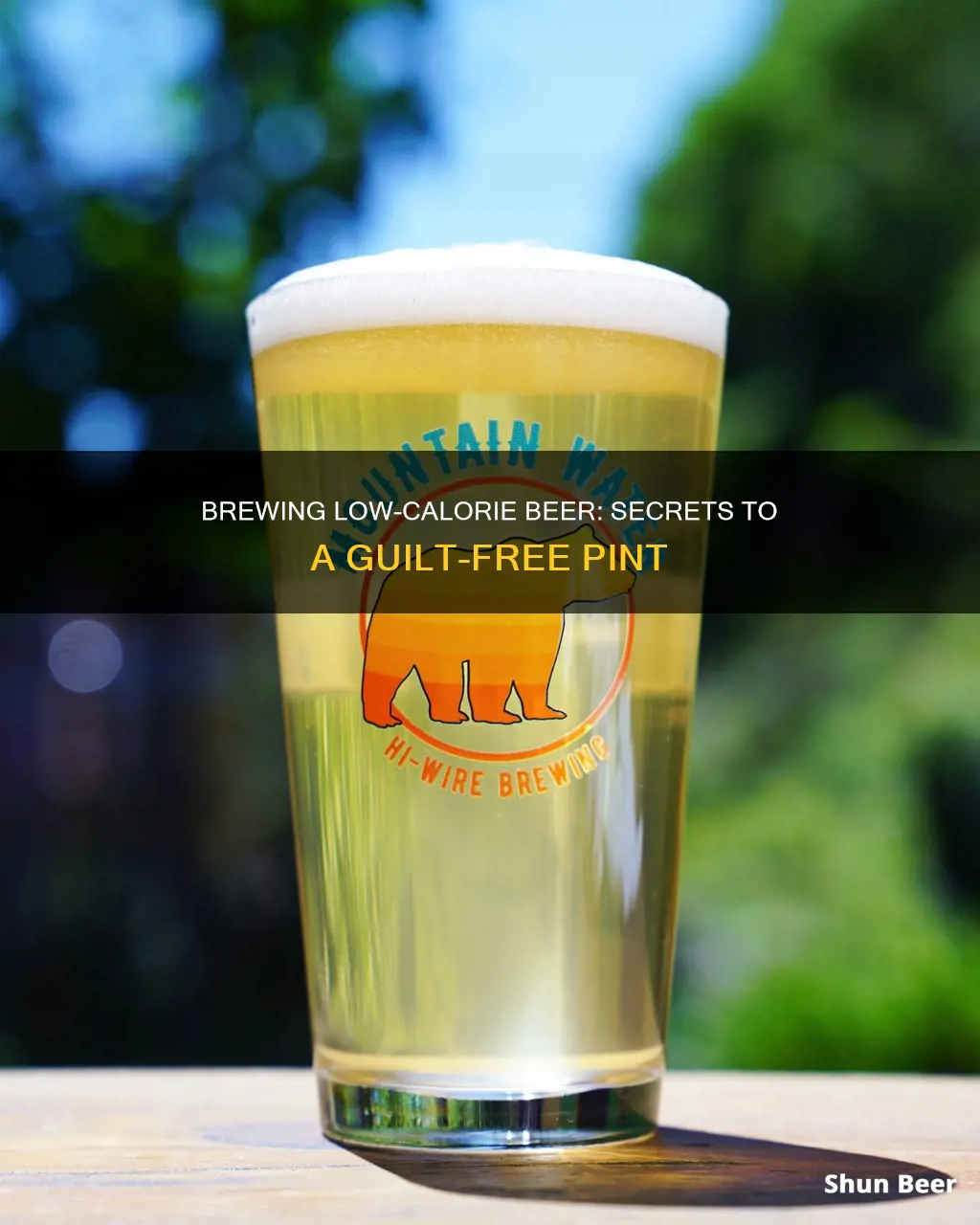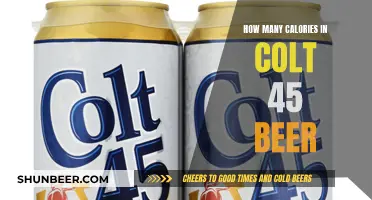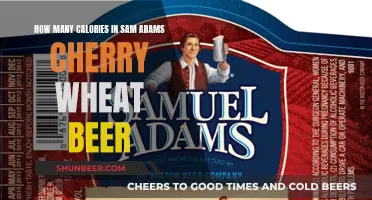
Brewing low-calorie beer is an appealing option for those who want to enjoy a drink without the extra calories. While commercial low-calorie beers have a poor reputation, you can brew your own at home with a wide variety of beer styles. The key to a good low-calorie beer is to balance body and flavour with a low calorie count, typically aiming for the 100-calorie mark.
Most of the calories in beer come from alcohol, so low-calorie beers need to be low in alcohol, generally lower than 4.5% ABV. The rest of the calories come from residual carbohydrates from malts and grains. To keep the calorie count low, it's important to minimise these residual carbohydrates, which can be achieved by using a high mashing temperature.
Additionally, brewers can add ingredients like specialty grains, malt, real fruit, and carefully selected hops to enhance flavour without increasing calories. For example, mango puree can be added towards the end of fermentation to impart a tropical fruit flavour without adding many calories.
Calculating the calories in a home-brewed beer can be done using the original gravity (OG) and final gravity (FG) measurements and a simple equation. By targeting specific OG and FG measurements, brewers can create low-calorie beers that are still enjoyable to drink.
| Characteristics | Values |
|---|---|
| Calories in an average 12 oz beer | 150 |
| Calories in a low-calorie 12 oz beer | 65-100 |
| Calories in alcohol | 2/3 of the calorie content in an average home-brewed beer |
| Calories in residual starches | 1/3 of the calorie content in an average home-brewed beer |
| Calories in beer | Alcohol calories + Carbohydrate calories |
| Alcohol calories | (1881.22 * FG * (OG-FG))/(1.775-OG) |
| Carbohydrate calories | 3550.0 * FG * ((0.1808 * OG) + (0.8192 * FG) – 1.0004) |
| Target calorie count | 100 |
| ABV for low-calorie beer | Lower than 4.5% |
| Carbohydrates in low-carb beer | Fewer than 5 grams per serving |
What You'll Learn

Using enzymes to break down complex carbohydrates
Brewing low-calorie beer is a complex process that requires careful manipulation of ingredients and conditions. One crucial aspect is the use of enzymes to break down complex carbohydrates, which can impact the flavour, mouthfeel, and calorie content of the final product.
Enzymes are complex proteins that act as biological catalysts, facilitating specific chemical reactions without being consumed in the process. In the context of brewing, enzymes can be manipulated to break down large, complex molecules, such as proteins and carbohydrates, into smaller components. This breakdown process is essential for converting starches and sugars, which are crucial for fermentation and the development of desired characteristics in the beer.
One class of enzymes that play a vital role in brewing is proteases, also known as protein-cleaving enzymes. These enzymes break down large proteins into smaller amino acid chains, which affect head retention and haze formation in the beer. By breaking down proteins, proteases also provide free nitrogen, a crucial nutrient for yeast, which is essential for the brewing process. Additionally, proteases can help prevent haze caused by excess proteins and polyphenols, enhancing the clarity of the brew.
Another important group of enzymes are the diastases, or starch-cleaving enzymes. These enzymes are responsible for breaking down starch, which is primarily composed of long chains of glucose molecules, into smaller, fermentable sugars. The two key diastatic enzymes in brewing are alpha-amylase and beta-amylase. Alpha-amylase chops up starch molecules randomly, creating smaller chains that beta-amylase can then convert into fermentable sugars, such as maltose and glucose. This process directly impacts the richness, body, and mouthfeel of the beer.
To create a low-calorie beer, brewers can manipulate the balance of alpha-amylase and beta-amylase to control the amount of starch converted into sugars. By favouring the use of beta-amylase, brewers can increase the amount of fermentable sugars, resulting in a drier-tasting beer with higher alcohol content. This approach helps reduce the presence of residual starches, which contribute to the calorie content of the beer.
Additionally, enzymes such as beta-glucanase and amyloglucosidase can be employed to further break down carbohydrate structures and reduce the calorie content. Beta-glucanase specifically targets glucans, which are polysaccharides made of glucose, improving wort viscosity and fermentability. Amyloglucosidase, on the other hand, breaks down starch into glucose, resulting in increased fermentability and lower calorie and carbohydrate content in the final beer.
By understanding the roles of these enzymes and carefully manipulating their presence and activity, brewers can create low-calorie beers with desirable characteristics. It is a delicate balance, as excessive breakdown of starch into fermentable sugars can lead to increased carbonation and a drier mouthfeel. Therefore, brewers must carefully control the conditions, including temperature and pH, under which these enzymes function to achieve the desired outcome.
Calories in New Glarus Beer: Nutritional Breakdown
You may want to see also

Lowering alcohol content
Lowering the alcohol content is key to reducing the calorie content of beer. Alcohol makes up about two-thirds of the calorie content of an average home-brewed beer, equating to roughly 30 calories per percent of ABV in a pint (half-litre) of beer.
To make a low-calorie beer, brewers must balance body and flavour with a low ABV, generally lower than 4.5%. This can be achieved by using a high mashing temperature, which results in more residual starches and a fuller-bodied beer. This also reduces fermentability, which will leave less alcohol for a given original gravity.
A low finishing gravity (below 1.010) will also result in a beer that is drier and lighter on the palate. Brewers can also use yeast with low attenuation, which will result in a higher finished gravity and less alcohol.
When it comes to selecting yeast, almost any brewer's yeast will work because the desired alcohol content is so low. However, it is important to select a yeast that the brewer has experience with and is comfortable using.
To calculate the calories in one serving of homebrew, a brewer needs two measurements: original gravity (OG) and final gravity (FG). These are both specific gravity measurements, usually taken with a hydrometer. OG is the specific gravity of the wort measured right before yeast is pitched; and FG is the final or finishing specific gravity measurement taken when fermentation has ceased completely.
The following equation can be used to calculate the total calories in the final beer:
Alcohol Calories = (1881.22 * FG * (OG-FG))/(1.775-OG)
Carbohydrate Calories = 3550.0 * FG * ((0.1808 * OG) + (0.8192 * FG) – 1.0004)
Total calories in the final beer = Alcohol Calories + Carbohydrate Calories
Kona Big Wave Beer: Calorie Count and Nutrition Facts
You may want to see also

Reducing residual starches and sugars
To reduce residual starches and sugars, brewers can employ several strategies. Firstly, using a lower-calorie sugar source is essential. For example, choosing a sugar source like corn or rice syrup instead of malt extract can help lower the calorie count. Additionally, brewers can add enzymes, such as Beano, to break down complex carbohydrates into simpler sugars that can be more easily fermented by yeast, resulting in fewer residual starches.
Another strategy is to use a high-temperature mash. Mashing at a higher temperature results in more residual starches but also creates a fuller-bodied beer. This technique is particularly useful for styles like English Bitters, Milds, and Scottish Light Ales. By mashing at a higher temperature, you can preserve body while reducing alcohol content.
Furthermore, brewers can select yeast strains with high attenuation, which will result in a higher finished gravity and less residual sugar. Choosing the right yeast is crucial, and brewers should opt for strains they are comfortable with and have experience using.
Finally, brewers can opt for styles with lower starting gravity and lower ABV, as alcohol can contribute significantly to the calorie count. Lower-ABV styles, such as Berliner Weiss, Scottish Light Ales, and Dry Irish Stouts, offer excellent options for creating low-calorie beers without sacrificing flavour.
By combining these strategies, brewers can effectively reduce residual starches and sugars, resulting in a delicious low-calorie beer that maintains body and flavour.
Calories in Summer Shandy Beer: How Much?
You may want to see also

Using low-calorie ingredients
Brewing a low-calorie beer requires a careful selection of ingredients to ensure the desired flavour and body are achieved without increasing the calorie count. Here are some tips for using low-calorie ingredients to brew a delicious beer:
Specialty Grains and Malts
Specialty grains and malts are a great way to add unique flavours to your beer without increasing the calorie content. For example, Anchor Brewing's Little Weekend, a 100-calorie golden ale, uses a blend of pale malt and Vienna malt, with the latter adding a bit more colour, residual sugar, and character to the beer. Anderson Valley Brewing Company's Black Rice Ale also uses a specialty grain, black rice, to impart an unusual umami flavour while keeping the beer light in calories.
Real Fruit
Fruit is another ingredient that can enhance the flavour of your low-calorie beer. Mango purée, for instance, adds a juicy and flashy tropical fruit flavour without the punchy acidity of citrus fruits. It's important to add the fruit purée towards the end of fermentation when the beer is close to reaching its final gravity. This ensures that the fruit sugars are metabolised by the yeast, preventing them from contributing to the final calorie count.
Carefully Selected Hops
When it comes to hops, the challenge is to extract maximum flavour without adding too much bitterness. This can be achieved by loading the back end of the beer with more hops and experimenting with different amounts and varieties. For example, Stone Brewing Company's Features and Benefits IPA uses a blend of Cashmere, Vic Secret, Azacca, and Mosaic hops to create pungent flavours of orange, pear, white peach, and melon while keeping the bitterness in check.
Enzymes
Enzymes, such as those found in Beano tablets, can be added to your wort to break down complex carbohydrates into simpler sugars that can be more easily converted into alcohol by the yeast. This results in a lower carbohydrate content in your final beer, making it drier and crispier.
Low-Temperature Mashes
Using lower mash temperatures can also help reduce calories. A mash step at 140-142°F (60-61°C) followed by a step at 148-150°F (64-66°C) ensures that the enzyme beta amylase is fully utilised to convert starch into sugars that can be completely fermented by the yeast. This results in lower gravity measurements and, consequently, a lower calorie beer.
Calories in Beer: Understanding the Count in Your 20oz Pint
You may want to see also

Calculating the calorie content
To calculate the calorie content of a beer, you need to measure its alcohol content and its residual carbohydrates. Alcohol contains roughly 7 calories per gram, and each percent of alcohol by volume (ABV) is roughly 30 calories per pint (half-litre) of beer. So, for a beer with a known ABV, you can calculate its calorie content.
However, this method does not account for the calories from residual carbohydrates. These are the starches and sugars that were not fully broken down during fermentation. To calculate the total calorie content of a beer, you need to measure its original gravity (OG) and final gravity (FG). OG is the specific gravity of the wort measured before yeast is added, and FG is the final specific gravity measured after fermentation. These measurements can be taken with a hydrometer.
There are online calculators that can calculate the calorie content of a beer using the OG and FG measurements. One such calculator uses the following equations:
Alcohol Calories = (1881.22 * FG * (OG-FG))/(1.775-OG)
Carbohydrate Calories = 3550.0 * FG * ((0.1808 * OG) + (0.8192 * FG) – 1.0004)
Total calories in the final beer = Alcohol Calories + Carbohydrate Calories
For example, a beer with an OG of 1.031 and an FG of 1.005 will have 3.41% ABV and exactly 100 calories per 12-ounce (354 ml) serving.
It is important to note that the calorie content of a beer is not solely dependent on its ABV. A beer with a higher FG will have more residual sugars and carbohydrates, resulting in a higher calorie count. Therefore, when aiming for a low-calorie beer, it is crucial to consider both the ABV and the FG.
Additionally, the type of ingredients used can also impact the calorie content. Specialty grains and malts, real fruit, and carefully selected hops can contribute flavour without significantly increasing the calorie count.
Microbrew Beer Calories: What's the Count?
You may want to see also
Frequently asked questions
A low-calorie beer typically has between 65 and 100 calories per 12 oz (1/3 liter) serving, compared to 150 calories in an average-strength beer.
To brew a low-calorie beer, you need to reduce the alcohol content and the residual carbs. You can do this by using a low starting gravity and a very attenuative yeast. You can also try adding enzymes to break down complex carbohydrates into sugars that can be converted to ethanol, resulting in fewer carbs and slightly more alcohol.
You can use specialty grains and malts, real fruit, and carefully selected hops to add flavour without increasing the calorie count. For example, you could use a small amount of Vienna malt to add colour, residual sugar, and character to a low-calorie beer. Or, you could use black rice as a specialty grain to add an unusual umami flavour. Mango puree is another option for adding flavour without bulk.
To calculate the calories in your home-brewed beer, you need to measure the original gravity (OG) and final gravity (FG) using a hydrometer. You can then plug these numbers into the following equation:
Alcohol Calories = (1881.22 * FG * (OG-FG))/(1.775-OG)
Carbohydrate Calories = 3550.0 * FG * ((0.1808 * OG) + (0.8192 * FG) – 1.0004)
Total calories in the final beer = Alcohol Calories + Carbohydrate Calories







